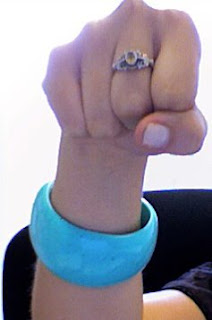Fist Bump...
Ever wonder where the fist bump came from?
I do.

Read on for a brief history lesson in the act of fist bumping...
A Brief History of the Fist Bump
The origins of the bump are murky, though most communication experts agree on a basic — if fuzzy — evolutionary timeline: the handshake (which itself dates back to ancient times) begat the "gimme-five" palm slap that later evolved into the now universal "high-five" and, finally, the fist bump.
Some claim the act of knuckle-bumping began in the 1970s with NBA players like Baltimore Bullets guard Fred Carter. Others claim the fist bump's national debut occurred off the court, citing the Wonder Twins, minor characters in the 1970s Hanna-Barbera superhero cartoon The Superfriends, who famously touched knuckles and cried "Wonder Twin powers, activate!' before morphing into animals or ice sculptures. One might also credit germaphobics for the fist bump's popularity. Deal or No Deal host Howie Mandel reportedly adopted the gesture as a friendly way to avoid his contestants' germs.
Even the terminology used to describe the manual move is under dispute. On reporting Obama's speech, The New York Times described it stuffily as a "closed-fisted high-five" while Human Events reader racily suggested it was closer to "Hezbollah-style fist-jabbing," (the comment was later removed from the article). One Internet poster even referred to it as "the fist bump of hope." Other terms for the move include "power five," "fist pound," "knuckle bump," "Quarter Pounder" and "dap."
The fist bump's precursor, the low- and high-fives, originated in the 1950s, again mostly among athletes, who deemed handshakes too muted and formal for celebrating teamwork and triumph. The 1980s are generally regarded as the heyday of the high-five, though the gesture has enjoyed a revival of sorts in recent years — especially among Gen-X parents and their offspring. Modern-day high-five enthusiasts have even created a cellphone version: Callers high-five their phones (slap the speakers) or simultaneously type "5."
The problem with the high-five is that it can occasionally be hard to pull off. Just ask Tiger Woods and his caddie, who botched a high-five on national TV during the 2005 U.S. Masters Golf Tournament. Perhaps this is what makes the fist bump so unique. Though simple in motion, its meaning is far more complicated. In any other context, a clenched fist would be perceived as hostile.
(story courtesy of Time.com. read the full story here...)
So go ahead, find a stranger and fist bump them today!


Comments